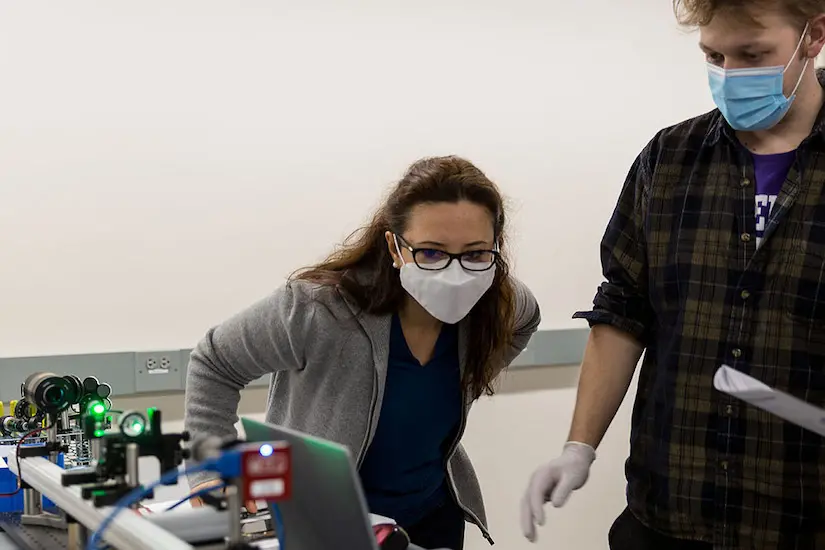Walk through any of the buildings on the University of Wisconsin-Madison College of Engineering campus and it won’t take you long to come across a microscope in a research lab. The device is a workhorse across disparate scientific fields of study.
Yet all too often, student researchers merely learn the functional basics of using microscopes—enough to get by in the short term, but not an expansive command that would allow them to fine tune optical tools for new research questions down the road.
 Assistant Professor Filiz Yesilkoy assists students during a recent session in the Department of Biomedical Engineering’s new teaching lab in the Engineering Centers Building.
Assistant Professor Filiz Yesilkoy assists students during a recent session in the Department of Biomedical Engineering’s new teaching lab in the Engineering Centers Building.
With that in mind, Biomedical Engineering Assistant Professor Filiz Yesilkoy is teaching students from a range of scientific disciplines the ins and outs of microscopes and other optical tools in a new biophotonics lab course.
“The goal of this course is to give a hands-on opportunity for students to use fundamental optical tools, like cameras, light sources, lenses, polarizers,” says Yesilkoy, who’s leading the course in the Department of Biomedical Engineering’s new teaching lab in the Engineering Centers Building. “They are the fundamental components of a microscope, of any imaging system.”
Students learn the foundational theory behind those components, then apply that knowledge while building tools like brightfield microscopes. They practice adjusting their microscope settings per the Kohler Illumination technique for optimal sample viewing. They evaluate different contrast methods across a range of microscopy methods. They use filters and spectrometers to measure and analyze light spectra. And they incorporate their new skills, all while examining biological samples.
Zach Gahl, a biomedical engineering master’s student, took a lecture-based course on optical theory with Yesilkoy during the fall 2021 semester. He’s enjoying the transition from working out problems on paper to putting together pieces in the lab.
“This is an opportunity to work with the hardware and actually get to set up a lot of the systems that we learned about,” says Gahl, who’s pursuing BME’s two-year, research-based master’s program while working in the lab of Associate Professor Kevin Eliceiri. “Rather than having everything in our brain, we actually get to see it all play out in real life.”
For the course, which was funded by a College of Engineering Education Innovation grant, Yesilkoy is using lab kits created by Thorlabs in partnership with optics instructors at the University of California, Berkeley. But she likens those kits to boxes of Legos whose pieces can be used to build new setups—some designed by students themselves—down the road. She already has plans to weave her research, which combines photonics, nanotechnology and biomedical science to develop novel biosensors, into the course in the future by asking students to investigate light’s interaction with nanomaterials.
While her spring 2022 cohort skews heavily graduate student, Yesilkoy hopes to reach more undergrads in future semesters as the course moves from a special topics class to a regular offering.
Regardless of how the course evolves, though, Yesilkoy is committed to imparting fundamental optical lessons to students from a broad swath of scientific disciplines—biology, chemistry, all engineering fields and beyond—empowering them to return to their coursework and research labs with the knowledge and skills to adapt to future challenges.
“I don’t care which department, which background you’re coming from, you’re going to learn microscopy taking my course,” she says. “You will have the toolbox in your hands.”